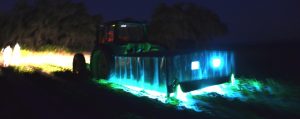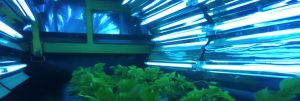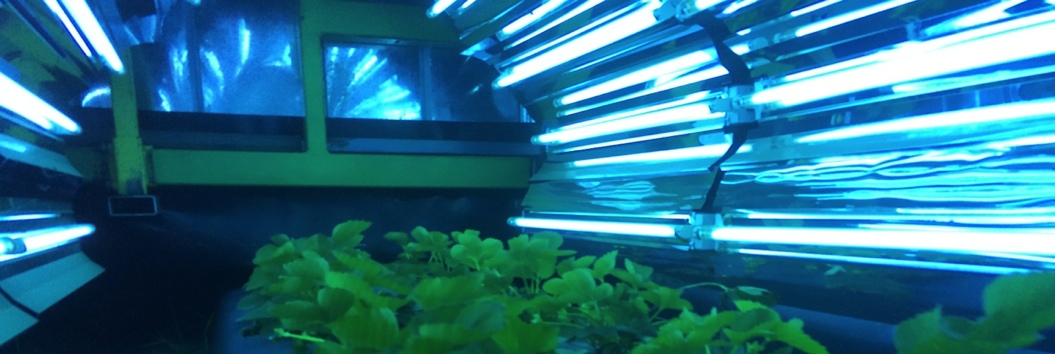
This UVC towable array was used in Florida trials at Wish Farm during one of the nighttime treatments. The unit treated two rows, but could be scaled up or down to treat larger or smaller areas.
How can UV light impact crop diseases? That’s a question David Gadoury has been trying to answer since 1991 in collaboration with universities in Norway, the Rensselaer Polytechnic Institute’s Lighting Research Center and the University of Florida. Gadoury, a senior research associate in Cornell’s Department of Plant Pathology, updated growers at the recent Agritech Trade Show in Plant City, Florida, on how UV light can be used to suppress powdery mildew on strawberries.
The research team works on all forms of light, but Gadoury focused specifically on shortwave UV light for his presentation. “We’re working with the germicidal portion of the solar spectrum,” Gadoury said. These short UV wavelengths (UVC) don’t usually reach the earth’s surface because they are screened out by the ozone layer.
Special fluorescent UV lamps produce the shorter wavelengths, which are widely used in industrial settings and hospitals. Although used for some industrial processes, UVC has only recently been successfully used to suppress plant diseases.
According to Gadoury, powdery mildew is the perfect disease to target in this research since it is a serious issue in strawberry production and the pathogen grows on the outside of the plant.
The research team capitalized on a discovery that the pathogen is extremely sensitive to UV light when it is applied at nighttime. Powdery mildew has adapted to exposure to UV light while the sun is shining. “Powdery mildew, along with many other organisms, has the capacity to repair damage caused by UV as it occurs, as long as it is coming from natural sources like the sun,” Gadoury explained.

The view underneath the hemi-cylindrical UVC light array underneath the unit. It was operated at a speed of just under 3 miles per hour.
According to Gadoury, organisms evolved to repair this damage over millions of years. “The organisms have evolved to upregulate the UV repair mechanisms in the presence of visible light from the sun, but the mechanism is also shut off at night, because there’s an energy cost to fixing damage from UV,” Gadoury said. Since these mechanisms are turned off at night, the pathogens are not able to repair the damage from even small doses of UV during darkness.
So, nighttime is ideal not only because the repair mechanisms are not operating, but also because a low dose of UV light can be used to destroy the pathogen without killing the plant.
The discovery that nighttime UV could be used at lower doses was made by Gadoury’s colleagues in Norway. It was a breakthrough in the research that rescued earlier failed daytime trials where UV was used to suppress powdery mildew on grapes. It “worked,” but also caused severe damage to the grapes. “We totally defoliated those grapevines,” Gadoury said.
Gadoury has seen a lot of success with UV light in greenhouses and high tunnel systems. He said the UV light can also work to control some insects on strawberries. All natural sources of UV are screened out by the glass and plastics used in most greenhouses, which is one of the reasons why powdery mildews are the number-one problem when plants are grown in greenhouses.
Gadoury encouraged growers to stay engaged with this research. The project website is called Light and Plant Health. He noted that the team is working with many grower cooperators. “We can do all these projects in controlled conditions, but the real learning takes place in a grower’s field,” Gadoury concluded.
Share this Post










